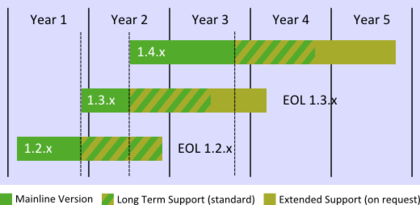Product Lifetime
The lifetime of products, especially software products, is not infinite. For our products we follow a very simple and straight forward strategy for their lifecycle. Whenever a new “Release” (new minor number) of a product becomes officially available, the days of the previous edition are numbered. The new “Mainline” becomes the active development line. The predecessor edition will automatically receive “long term support (LTS)” status and will get bug fixes for at least one year. The support status of a product during its lifetime is shown in the following figure.
- Mainline Version (ML)
This is the current version of a product. The mainline is actively developed, enhanced, improved and maintained. All new features and extensions including new components will be developed based on this version. As a new customer, you will get the latest edition of exactly this version.
- Long Term Support Status (LTS)
With the release of a new mainline version, typically the status of the direct predecessor changes to long term support. For instance, when the version number changes from 1.3.x to 1.4.0, 1.4.x becomes the new mainline version and 1.3.x enters the long term support period. No new features will be incorporated during the LTS phase, but we will provide bug fixes if required. The standard duration of the long term support period is one year (365 days starting from the release date of the successor). Therefore, you, the customer, have at least 1 year time to migrate your application to the next SDK version. In addition, we offer an extended support period (max. another year) on request. This means that you can get bug fixes (no new features) without having to upgrade to the successor mainline version. The prolongation of the LTS period, the so-called extended support, is only available on request and usually charged.
- End Of Life (EOL)
A product reaches its end of life (EOL) status when the long term support period has ended. The end of life means that there will be no support nor any bug fixing updates for this product anymore. If your application is using a product edition that will reach its end of life soon, you should quickly update to the successor or the mainline. If, for any reason, you cannot or will not do that, you should opt for the source code edition of that particular product in order to bug fix and maintain it yourself.


